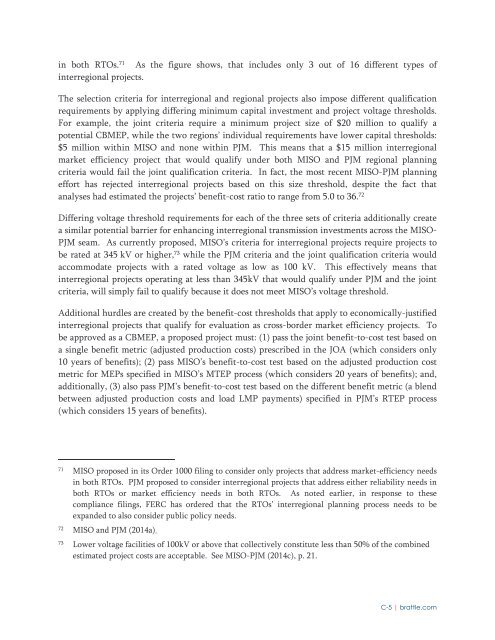THE BRATTLE GROUP
pvrbYG
pvrbYG
Create successful ePaper yourself
Turn your PDF publications into a flip-book with our unique Google optimized e-Paper software.
in both RTOs. 71 As the figure shows, that includes only 3 out of 16 different types of<br />
interregional projects.<br />
The selection criteria for interregional and regional projects also impose different qualification<br />
requirements by applying differing minimum capital investment and project voltage thresholds.<br />
For example, the joint criteria require a minimum project size of $20 million to qualify a<br />
potential CBMEP, while the two regions’ individual requirements have lower capital thresholds:<br />
$5 million within MISO and none within PJM. This means that a $15 million interregional<br />
market efficiency project that would qualify under both MISO and PJM regional planning<br />
criteria would fail the joint qualification criteria. In fact, the most recent MISO-PJM planning<br />
effort has rejected interregional projects based on this size threshold, despite the fact that<br />
analyses had estimated the projects’ benefit-cost ratio to range from 5.0 to 36. 72<br />
Differing voltage threshold requirements for each of the three sets of criteria additionally create<br />
a similar potential barrier for enhancing interregional transmission investments across the MISO-<br />
PJM seam. As currently proposed, MISO’s criteria for interregional projects require projects to<br />
be rated at 345 kV or higher, 73 while the PJM criteria and the joint qualification criteria would<br />
accommodate projects with a rated voltage as low as 100 kV. This effectively means that<br />
interregional projects operating at less than 345kV that would qualify under PJM and the joint<br />
criteria, will simply fail to qualify because it does not meet MISO’s voltage threshold.<br />
Additional hurdles are created by the benefit-cost thresholds that apply to economically-justified<br />
interregional projects that qualify for evaluation as cross-border market efficiency projects. To<br />
be approved as a CBMEP, a proposed project must: (1) pass the joint benefit-to-cost test based on<br />
a single benefit metric (adjusted production costs) prescribed in the JOA (which considers only<br />
10 years of benefits); (2) pass MISO’s benefit-to-cost test based on the adjusted production cost<br />
metric for MEPs specified in MISO’s MTEP process (which considers 20 years of benefits); and,<br />
additionally, (3) also pass PJM’s benefit-to-cost test based on the different benefit metric (a blend<br />
between adjusted production costs and load LMP payments) specified in PJM’s RTEP process<br />
(which considers 15 years of benefits).<br />
71<br />
MISO proposed in its Order 1000 filing to consider only projects that address market-efficiency needs<br />
in both RTOs. PJM proposed to consider interregional projects that address either reliability needs in<br />
both RTOs or market efficiency needs in both RTOs. As noted earlier, in response to these<br />
compliance filings, FERC has ordered that the RTOs’ interregional planning process needs to be<br />
expanded to also consider public policy needs.<br />
72<br />
MISO and PJM (2014a).<br />
73<br />
Lower voltage facilities of 100kV or above that collectively constitute less than 50% of the combined<br />
estimated project costs are acceptable. See MISO-PJM (2014c), p. 21.<br />
C-5 | brattle.com


